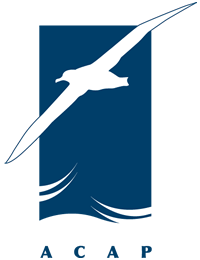 A suspected case of HPAI in a Black-browed Albatross is under investigation and awaiting tests according to AWHN's table of 'suspected and confirmed HPAI events in the sub-Antarctic and Antarctica' on the SCAR website; photograph by Ian Strange
A suspected case of HPAI in a Black-browed Albatross is under investigation and awaiting tests according to AWHN's table of 'suspected and confirmed HPAI events in the sub-Antarctic and Antarctica' on the SCAR website; photograph by Ian Strange
The Scientific Committee on Antarctic Research’s (SCAR) Antarctic Wildlife Health Network (AWHN) has implemented a database for High Pathogenicity Avian Influenza (HPAI) to track and document data provided to the AWHN regarding the spread of HPAI outbreaks in the sub-Antarctic and Antarctica during the Austral Summer of 2023/24.
As stated on the SCAR website, information submitted to the database will be used to:
- Monitor the movement and spread of HPAI in the sub-Antarctic and Antarctic region.
- Update the AWHN risk assessment for wildlife species and geographical regions.
- Update recommendations and guidelines for surveillance, monitoring and response to HPAI as we learn from this outbreak.
- Update the polar community on current suspected and confirmed outbreaks of HPAI and to further understand the biology and movement of this virus.
- Analyse the movement of HPAI and its impacts on wildlife colonies based on reported data.
More information on the monitoring project can be found at the SCAR website, here, or for enquiries related to the database, please email,
ACAP recently released an updated version of its Guidelines for working with albatrosses and petrels during the high pathogenicity avian influenza (HPAI) H5N1 panzootic, first published in July 2022. The guidelines were produced by the Agreement's High Pathogenicity H5N1 Avian Influenza Intersessional Group in response to the growing concern of avian influenza’s potential impact on ACAP-listed species. The Intersessional Group consists of thirteen experts on epidemiology, disease risk assessment and management who advise the Agreement on issues related to the ongoing H5N1 avian influenza outbreak.
In commenting on the overall scenario and the updated guidelines, Patricia Serafini, Co-convenor of the Agreement’s Population and Conservation Status Working Group (PaCSWG) and member of the ACAP Intersessional Group on HPAI said:
"High pathogenicity Avian Influenza (HPAI), caused by the virus H5N1, results in rapid and high mortality in infected wildlife groups. Researchers and authorities have been engaged in studying and understanding the impacts of this ongoing panzootic since the first ACAP guidelines on HPAI were released in 2022, and a lot of new information has been released. Migratory bird species arriving to the Southern Ocean (mostly between September and November) could transmit HPAI to the region, coinciding with the arrival of breeding seabirds, including ACAP species. Furthermore, it is possible that the virus could survive in the environment beyond the austral summer. Considering the present global panzootic scenario and the new information available, experts from several countries have been engaged together in an ACAP intersessional group to update and provide managers and ACAP Parties with the most up-to-date guidance for surveillance, monitoring, and response for HPAI outbreaks that might occur this season."
Further information on Avian Flu, including the updated guidelines, can be found at the ACAP website under Resources>Disease Threats>Avian Flu, here.
24 November 2023

 Français
Français  English
English  Español
Español